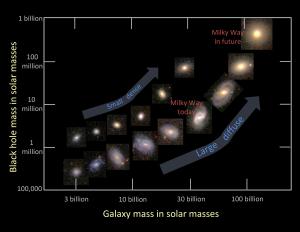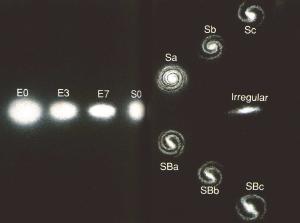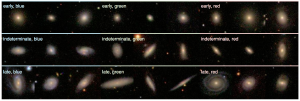Blog
How Galaxies Die
20 July 2020
 Sandra Faber/Sofia Quiros/SDSS
Sandra Faber/Sofia Quiros/SDSSIn the 1920s, Edwin Hubble studied hundreds of galaxies. He found that they tended to fall into a few broad types. Some contained elegant spirals of bright stars, while others were spherical or elliptical with little or no internal structure. In 1926 he developed a classification scheme for galaxies, now known as Hubble’s Tuning Fork.
 Edwin Hubble
Edwin HubbleWhen you look at Hubble’s scheme, it suggests an evolution of galaxies, beginning as an elliptical galaxy, then flattening and shifting into a spiral galaxy. While many saw this as a reasonable model, Hubble cautioned against jumping to conclusions. We now know ellipticals do not evolve into spirals, and the evolution of galaxies is complex. But Hubble’s scheme marks the beginning of the attempt to understand how galaxies grow, live, and die.
One of the things astronomers have learned since Hubble is that galactic evolution is less about shape and more about the production of stars. Galaxies in the process of creating stars have regions of bright blue stars. Since large blue stars don’t live long on a cosmic scale, their presence indicates recent star formation. Galaxies toward the end of their lives are filled with dim, red stars. Red dwarf stars have the longest lifetime, so they are all that remains as a galaxy becomes inactive. Between these two eras is a transition period, known as the green era.
 Galaxy Zoo
Galaxy ZooSince ellipticals, spirals and irregular galaxies can all be in a blue, green, or red era, it is clear that galactic structure doesn’t drive star production. Instead, the primary driver seems to be black holes. Most galaxies contain a supermassive black hole in their centers. These black holes cause gas and dust to gather around the galactic center, which can trigger the formation of new stars. But when supermassive black holes consume nearby matter and enter an active period, they can drive gas and dust from the galaxy, quenching star production.
A new study looks at this interplay between black holes and star production and presents an interesting theory on how and why galaxies die.1 The study used data from the Cosmic Assembly Near-infrared Deep Extragalactic Legacy Survey (CANDELS), which is the largest survey of galaxies ever made. The research team found that more diffuse galaxies such as the Milky Way have longer periods of star production than more compact galaxies. This is true even when two galaxies have the same overall total mass.
While this makes sense, the surprising finding was that this relation correlates to the density of a galaxy’s central region. More diffuse galaxies take longer for their central region to reach a critical density, and it is at this critical density that star production drops off. Since the central density of a galaxy is a good measure of the size of its supermassive black hole, this finding supports the “feedback” model of galactic evolution.
According to this theory, galactic evolution is driven by the central black hole. As the black hole forms, a dense central region forms with it. But as the black hole grows larger, it heats the central region to the point where gas and dust are pushed away, stripping the galaxy of the material it needs to create new stars. In small, dense galaxies this transition happens quickly, while it happens more slowly in large, diffuse galaxies.
While there is more research to be done, this feedback loop seems to be the most likely. So it seems that while supermassive black holes give birth to galaxies filled with stars, they also push galaxies to their dim and red demise.
Chen, Zhu, et al. “Quenching as a Contest between Galaxy Halos and Their Central Black Holes.” The Astrophysical Journal 897.1 (2020): 102. ↩︎